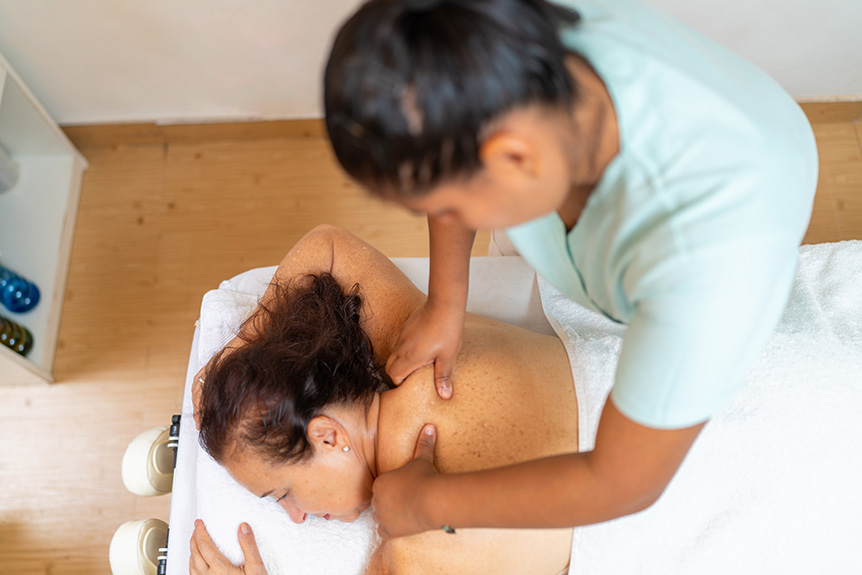Yes—brief, mild “sick” feelings can follow this massage. Firm pressure mobilizes fascia, shifts fluid, and downshifts the autonomic nervous system, which may cause light-headedness, fatigue, headache, or nausea. Short-lived muscle soreness is common, like post-exercise fatigue. Hydration, slow position changes, gentle breathing, and light walking usually help. Seek care for sharp pain, persistent dizziness, severe headache, fever, or worsening swelling. Therapists minimise effects by grading pressure and monitoring comfort. Further guidance explains what’s normal, warning signs, and recovery tips.
Why You Might Feel Unwell After a Deep Tissue Massage

Although this massage is generally safe and beneficial, some clients may feel temporarily unwell afterward due to normal physiological responses. Firm pressure mobilises fascial layers, increases local circulation, and stimulates the autonomic nervous system. This can transiently lower blood pressure, leaving someone light‑headed or fatigued.
Microtrauma within tight muscle fibres may release inflammatory mediators, creating short‑lived soreness. Enhanced lymphatic flow can shift interstitial fluid, prompting mild nausea if a person arrives dehydrated or fasted.
At Spa & Massage clinics in London, therapists tailor depth gradually, monitor breathing, and avoid excessive load on sensitive areas to minimise these effects. They encourage slow passages off the couch, water intake, and gentle movement after sessions.
When clients share medications, sleep patterns, and training loads, pressure can be precisely calibrated for comfort and recovery.
In some cases, incorporating aromatherapy massage techniques can support relaxation and overall wellbeing during and after a massage session.
Common Post-Massage Reactions and What’s Normal
After understanding why some people feel unwell post-treatment, it helps to know which reactions fall within a normal recovery window. Many experience next-day muscle soreness—similar to a strength workout—as collagen-rich tissues adapt to pressure.
Mild fatigue, thirst, and a warm, heavy-limbed ease are common as circulation and lymphatic flow increase. Light-headedness can occur briefly when getting up; rising slowly helps.
Local tenderness, faint redness, or small petechiae from focused trigger-point work may appear but typically settle within 24–72 hours. Transient headache or queasiness can reflect autonomic downshifting and fluid shifts; hydration and unhurried breathing usually soothe this.
At Spa & Massage, therapists recommend water, gentle stretching, a warm shower, and unhurried rest. Many clients choose calmer evenings, nourishing meals, and minimal alcohol to support recovery.
When to Be Concerned and Who Should Avoid Deep Tissue
Should discomfort escalate beyond typical post‑treatment soreness, certain signs warrant attention. Red flags include sharp or radiating pain, persistent numbness or tingling, new weakness, severe headache, chest pain, fever, rash, or swelling that spreads.
Marked bruising, dizziness that does not settle with rest and hydration, or pain disrupting sleep beyond 48 hours also merits review.
At Spa & Massage, therapists advise pausing activity and contacting a clinician if these arise.
Deep tissue is not appropriate for acute injuries, active infections, uncontrolled hypertension, bleeding disorders, anticoagulant use, severe osteoporosis, recent surgery, or open wounds.
It should be avoided over varicose veins, thrombosis, or areas of loss of sensation.
During pregnancy, only pregnancy‑adapted massage is advised.
Cancer care, diabetes with neuropathy, and autoimmune flares require medical clearance and gentler techniques.
How We Minimise Discomfort During and After Your Session
Prior red flags aside, most discomfort linked to deep tissue work can be reduced with skilled technique and planning. At Spa & Massage, therapists begin with a brief screen for recent illness, medications, and tissue sensitivity, then calibrate pressure with the client’s breath and verbal feedback.
They warm tissues first—using slow effleurage and heat—to lower muscle spindle reactivity before layering focused friction, stripping, or trigger point work.
They vary angle and shear to respect fibre orientation in the traps, glutes, calves, and forearms, and they avoid excessive compression over lymph nodes and bony landmarks.
Communication remains intimate yet precise: a 6–7/10 pressure ceiling, never sharp or nervy.
Neutral, hypoallergenic oils minimize skin irritation.
Sessions close with gentle decompression and paced transitions to upright, reducing post-treatment light-headedness.
Practical Aftercare to Support Recovery and Wellbeing
Though thismassage can leave tissues sensitised for 24–48 hours, simple aftercare can optimise circulation, reduce soreness, and consolidate gains in mobility.
At Spa & Massage, therapists recommend steady hydration to support microvascular perfusion, light walking to maintain lymph flow, and unhurried breaths to calm the autonomic nervous system.
Gentle active range-of-motion keeps fascia supple without overloading tender motor units.
For local tenderness, alternate brief cool compresses with warm showers to modulate inflammation and ease hypertonic bands.
Prioritise sleep; tissues remodel during deep stages.
Avoid heavy lifting, alcohol, and high-heat saunas for a day.
Nourish with protein and colourful plants to fuel repair.
Clients may book a shorter follow-up within a week.
In our clinics, therapists tailor home stretches, self-massage techniques, and aromatherapy advice to each body’s needs.
Conclusion
In the end, feeling lightheaded, achy, or mildly “fluey” after deep tissue work is usually a transient response to increased circulation, fascial release, and nervous system recalibration—sensations that often settle within 24–48 hours. With paced pressure, clear communication, hydration, and gentle movement, most clients recover smoothly and gain lasting mobility. Still, red-flag symptoms warrant prompt advice. Approached thoughtfully, this massage can transform tension so profoundly it feels as if a mountain has shifted—safely, purposefully, and with the client in control.



